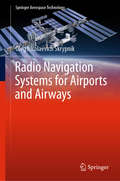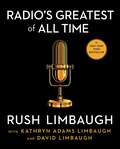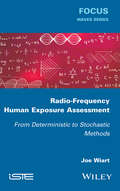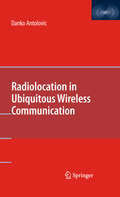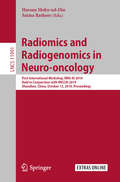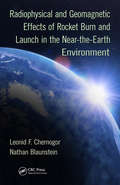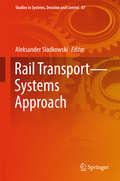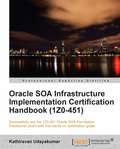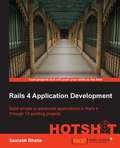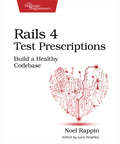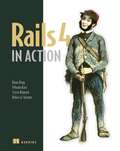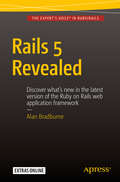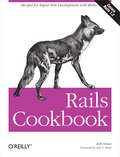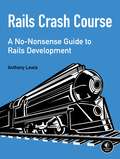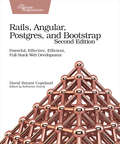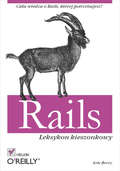- Table View
- List View
Radio Navigation Systems for Airports and Airways (Springer Aerospace Technology)
by Oleg Nicolaevich SkrypnikThis book highlights the design principles of ground based radio-navigation systems used in solving navigation tasks in the airfield and on air routes. Mathematical correlations are illustrated that describe its operation, peculiarities of disposition, main technical characteristics, generalized structural diagrams as well as the inter-operation with onboard equipment. Examples of building, construction, functional diagrams, and characteristics of Russian made radio-navigation systems are discussed. This book is written for students of electronics and aviation disciplines. It can also be useful for aviation specialists as well as for those interested in air radio-navigation.
Radio Propaganda and the Broadcasting of Hatred
by Keith SomervilleAn exposition and analysis of the development of propaganda, focusing on how the development of radio transformed the delivery and impact of propaganda and led to the use of radio to incite hatred and violence.
Radio Wave Propagation and Channel Modeling for Earth-Space Systems
by Athanasios G. Kanatas Athanasios D. PanagopoulosThe accurate design of earth–space systems requires a comprehensive understanding of the various propagation media and phenomena that differ depending on frequencies and types of applications. The choice of the relevant channel models is crucial in the design process and constitutes a key step in performance evaluation and testing of earth–space systems. The subject of this book is built around the two characteristic cases of satellite systems: fixed satellites and mobile satellite systems. <P><P>Radio Wave Propagation and Channel Modeling for Earth–Space Systems discusses the state of the art in channel modeling and characterization of next-generation fixed multiple-antennas and mobile satellite systems, as well as propagation phenomena and fade mitigation techniques. The frequencies of interest range from 100 MHz to 100 GHz (from VHF to W band), whereas the use of optical free-space communications is envisaged.Examining recent research advances in space-time tropospheric propagation fields and optical satellite communication channel models, the book covers land mobile multiple antennas satellite- issues and relative propagation campaigns and stratospheric channel models for various applications and frequencies. It also presents research and well-accepted satellite community results for land mobile satellite and tropospheric attenuation time-series single link and field synthesizers.The book examines aeronautical communications channel characteristics and modeling, relative radio wave propagation campaigns, and stratospheric channel model for various applications and frequencies. Propagation effects on satellite navigation systems and the corresponding models are also covered.
Radio and the Gendered Soundscape
by Christine EhrickThis book is a history of women, radio, and the gendered constructions of voice and sound in Buenos Aires, Argentina, and Montevideo, Uruguay. Through the stories of five women and one radio station, this study makes a substantial theoretical contribution to the study of gender, mass media, and political culture and expands our knowledge of these issues beyond the US and Western Europe. Included here is a study of the first all-women's radio station in the Western Hemisphere, an Argentine comedian known as 'Chaplin in Skirts', an author of titillating dramatic serials and, of course, Argentine First Lady 'Evita' Perón. Through the concept of the gendered soundscape, this study integrates sound studies and gender history in new ways, asking readers to consider both the female voice in history and the sonic dimensions of gender.
Radio and the Politics of Sound in Interwar France, 1921–1939
by Rebecca P. ScalesIn December 1921, France broadcast its first public radio program from a transmitter on the Eiffel Tower. In the decade that followed, radio evolved into a mass media capable of reaching millions. Crowds flocked to loudspeakers on city streets to listen to propaganda, children clustered around classroom radios, and families tuned in from their living rooms. Radio and the Politics of Sound in Interwar France, 1921–1939 examines the impact of this auditory culture on French society and politics, revealing how broadcasting became a new platform for political engagement, transforming the act of listening into an important, if highly contested, practice of citizenship. Rejecting models of broadcasting as the weapon of totalitarian regimes or a tool for forging democracy from above, the book offers a more nuanced picture of the politics of radio by uncovering competing interpretations of listening and diverse uses of broadcast sound that flourished between the world wars.
Radio's Greatest of All Time
by Rush Limbaugh#1 NEW YORK TIMES BESTSELLER A collection of Rush Limbaugh&’s greatest on-air moments, with special commentary and personal stories from his beloved widow, Kathryn Limbaugh, and brother, David Limbaugh.For more than thirty years, millions of listeners tuned in to hear Rush Limbaugh&’s voice. At its peak, The Rush Limbaugh Show aired on more than 650 radio stations nationwide, and his inimitable commentary and distinctive sense of humor garnered a devoted audience that celebrated with him when he received the Presidential Medal of Freedom in 2020. Rush&’s passing the following year sent shock waves through the conservative and broadcasting communities. In this timeless collection of his best work, his triumphant legacy as the greatest voice for conservatism is cemented in history. When Rush&’s dear friend Vince Flynn first suggested the idea of this book, Rush considered the task daunting. &“How can I possibly select the best of the best,&” he joked, &“from all the years of pure genius?&” Over time, Rush came to love this project immensely, and recalled incredible details from his childhood and early career. Featuring commentary from loved ones, family, friends, and prominent figures such as President Donald Trump, Supreme Court Justice Clarence Thomas, Governor Ron DeSantis, and more, Radio&’s Greatest of All Time is the ultimate gift for any devoted listener and leaves no doubt about his profound impact on this country.
Radio, Public Life and Citizen Deliberation in South Africa (Routledge Contemporary South Africa)
by Sarah ChiumbuThis book critically analyses the important role of radio in public life in post-apartheid South Africa. As the most widespread and popular form of communication in the country, radio occupies an essential space in the deliberation and the construction of public opinion in South Africa. From just a few state-controlled stations during the apartheid era, there are now more than 100 radio stations, reaching vast swathes of the population and providing an important space for citizens to air their views and take part in significant socio-economic and political issues of the country. The various contributors to this book demonstrate that whilst print and television media often serve elite interests and audiences, the low cost and flexibility of radio has helped it to create a ‘common’ space for national dialogue and deliberation. The book also investigates the ways in which digital technologies have enhanced the consumption of radio and produced a sense of imagined community for citizens, including those in marginalised communities and rural areas. This book will be of interest to researchers with an interest in media, politics and culture in South Africa specifically, as well as those with an interest in broadcast media more generally.
Radio-Frequency Human Exposure Assessment
by Joe WiartNowadays approximately 6 billion people use a mobile phone and they now take a central position within our daily lives. The 1990s saw a tremendous increase in the use of wireless systems and the democratization of this means of communication. To allow the communication of millions of phones, computers and, more recently, tablets to be connected, millions of access points and base station antennas have been extensively deployed. Small cells and the Internet of Things with the billions of connected objects will reinforce this trend. This growing use of wireless communications has been accompanied by a perception of risk to the public from exposure to radio frequency (RF) electromagnetic field (EMF). To address this concern, biomedical research has been conducted. It has also been important to develop and improve dosimetry methods and protocols that could be used to evaluate EMF exposure and check compliance with health limits. To achieve this, much effort has was made in the 1990s and 2000s. Experimental and numerical methods, including statistical methods, have been developed. This book provides an overview and description of the basic and advanced methods that have been developed for human RF exposure assessment. It covers experimental, numerical, deterministic and stochastic methods.
Radiolocation in Ubiquitous Wireless Communication
by Danko AntolovicThe subject of the book is application of multi-antenna radiolocation to the environment of fast, ubiquitous wireless communication among portable devices. It is a systematic presentation of the author's research and development in the field, within the 802.11b standard, while explaining the general principles and exploring applications to other standards and situations. The purpose is to fill a gap in the current technical literature and present the issues involved in locating mobile wireless network agents, in a single volume, accessible to system designers and other practitioners in the wireless field.
Radiomics and Radiogenomics in Neuro-oncology: First International Workshop, RNO-AI 2019, Held in Conjunction with MICCAI 2019, Shenzhen, China, October 13, Proceedings (Lecture Notes in Computer Science #11991)
by Hassan Mohy-ud-Din Saima RathoreThis book constitutes the proceedings of the First International Workshop on Radiomics and Radiogenomics in Neuro-oncology, RNO-AI 2019, which was held in conjunction with MICCAI in Shenzhen, China, in October 2019. The 10 full papers presented in this volume were carefully reviewed and selected from 15 submissions. They deal with the development of tools that can automate the analysis and synthesis of neuro-oncologic imaging.
Radiophysical and Geomagnetic Effects of Rocket Burn and Launch in the Near-the-Earth Environment
by Nathan Blaunstein Leonid F. ChernogorRadiophysical and Geomagnetic Effects of Rocket Burn and Launch in the Near-the-Earth Environment describes experimental and theoretical studies on the effects of rocket burns and launchings on the near-the-Earth environment and geomagnetic fields. It illuminates the main geophysical and radiophysical effects on the ionosphere and magnetosphere sur
Rail Transport—Systems Approach
by Aleksander SładkowskiThis book shows how the systems approach is employed by scientists in various countries to solve specific problems concerning railway transport. In particular, the book describes the experiences of scientists from Romania, Germany, the Czech Republic, the UK, Russia, Ukraine, Lithuania and Poland. For many of these countries there is a problem with the historical differences between the railways. In particular, there are railways with different rail gauges, with different signaling and communication systems, with different energy supplies and, finally, with different political systems, which are reflected in the different approaches to the management of railway economies. The book’s content is divided into two main parts, the first of which provides a systematic analysis of individual means of providing and maintaining rail transport. In turn, the second part addresses infrastructure and management development, with particular attention to security issues. Though primarily written for professionals involved in various problems concerning railway transport, the book will also benefit manufacturers, railway technical staff, managers, and students with transport specialties, as well as a wide range of readers interested in learning more about the current state of transport in different countries.
Railo 3 Beginner’s Guide
by Mark Drew Gert FranzPart of Packt's Beginner's Guide series, this book uses practical examples and screenshots to steadily guide the reader through setting up and using Railo. If you want to develop your own dynamic web applications using CFML, then this book is for you. No prior experience with Railo or CFML is required, although you will be expected to have some web application development experience and knowledge of HTML.
Rails 4 Application Development HOTSHOT
by Saurabh BhatiaAttractive practical projects to polish your application building skills, through a straightforward, highly focused and interesting approach towards application development. If you are a developer who is already familiar with the basics of the Rails framework and have previously worked with Rails 3.2 or earlier, then this is the ideal book for you. It is assumed that you have some prior experience with the development of applications. This book will help you to upgrade your existing knowledge and also ensure its applicability. You will be expected to setup Rails, MySQL / PostgreSQL, Mongodb and required dependencies themselves.
Rails 4 Test Prescriptions: Build a Healthy Codebase
by Noel RappinDoes your Rails code suffer from bloat, brittleness, or inaccuracy? Cure these problems with a regular dose of test-driven development. Rails 4 Test Prescriptions is a comprehensive guide to how tests can help you design and write better Rails applications. In this completely revised edition, you'll learn why testing works and how to test effectively using Rails 4, Minitest 5, and RSpec 3, as well as popular testing libraries such as factory_girl and Cucumber. Do what the doctor ordered to make your applications feel all better. Side effects may include better code, fewer bugs, and happier developers.Your Ruby on Rails application is sick. Deadlines are looming, but every time you make the slightest change to the code, something else breaks. Nobody remembers what that tricky piece of code was supposed to do, and nobody can tell what it actually does. Plus, it has bugs. You need test-driven development, a process for improving the design, maintainability, and long-term viability of software.Containing both practical code examples and discussion of why testing works, this book starts with the most basic features delivered as part of core Ruby on Rails. Once you've integrated those features into your coding practice, you'll learn how to use popular third-party testing tools such as RSpec, Mocha, Cucumber, and factory_girl. You'll test the component parts of a Rails application, including the back-end model logic and the front-end display logic. Using Rails examples, you'll learn how to use testing to enable your code to respond better to future change. Plus, you'll see how to handle real-world testing situations.This completely revised edition contains a new tutorial, as well as new examples throughout the book. Many chapters, including the JavaScript chapter, have undergone major changes to reflect new tools and new practices. And there are brand new chapters on testing for security, and testing external services.What You Need:Ruby 2.1, Rails 4
Rails 4 in Action: Revised Edition of Rails 3 in Action
by Rebecca Skinner Yehuda Katz Ryan Bigg Stephen KlabnikSummaryRails 4 in Action is a comprehensive introduction to Rails that guides you hands-on through all you'll need to become a competent and confident Rails developer. In it, you'll master Rails 4 by developing a ticket-tracking application that includes RESTful routing, authentication and authorization, file uploads, email, and more.Purchase of the print book includes a free eBook in PDF, Kindle, and ePub formats from Manning Publications.About the BookRails is a full-stack, open source web framework powered by Ruby. Now in version 4, Rails is mature and powerful, and to use it effectively you need more than a few Google searches. You'll find no substitute for the guru's-eye-view of design, testing, deployment, and other real-world concerns that this book provides.Rails 4 in Action is a hands-on guide to the subject. In this fully revised new edition, you'll master Rails 4 by developing a ticket-tracking application that includes RESTful routing, authentication and authorization, file uploads, email, and more. Learn to design your own APIs and successfully deploy a production-quality application. You'll see test-driven development and behavior-driven development in action throughout the book, just like in a top Rails shop.What's InsideCreating your own APIsUsing RSpec and CapybaraEmphasis on test-first developmentFully updated for Rails 4About the ReaderFor readers of this book, a background in Ruby is helpful but not required. No Rails experience is assumed.About the AuthorsRyan Bigg, Yehuda Katz, Steve Klabnik, and Rebecca Skinner are contributors to Rails and active members of the Rails community.Table of ContentsRuby on Rails, the frameworkTesting saves your baconDeveloping a real Rails applicationOh, CRUD!Nested resourcesAuthenticationBasic access controlFine-grained access controlFile uploadingTracking stateTaggingSending emailDeploymentDesigning an APIRack-based applications
Rails 5 Revealed
by Alan BradburneThis short early adopter book details both how you'll upgrade existing web and other applications from Rails 4. 2 to 5 and how to create new applications in Rails 5. The headline features, Rails API and ActionCable, are each looked at in detail, building small example projects to demonstrate how to build a JSON API, add real-time notifications to a page and how to create a single-page application. All the breaking changes are shown, along with how to fix your app to work with the new API, and the improvements to ActiveRecord and the testing framework are fully detailed. After reading and using Rails 5 Revealed, you'll be poised to move forward with building your apps with the new Rails 5 as it stands now and when it finalizes. What you'll learn What are the new changes to Rails 5 and how to upgrade from Rails 4. 2 How to use the new Ruby Persistence tool/framework, ActiveRecord How to handle test framework changes What are the latest Rails API and how to employ them What is and how to use the new ActionCable Who this book is for This short book is aimed at existing Rails developers who are looking to quickly get up to speed with the changes in the new Rails 5 framework.
Rails 5 Test Prescriptions: Build a Healthy Codebase
by Noel RappinDoes your Rails code suffer from bloat, brittleness, or inaccuracy? Cure these problems with the regular application of test-driven development. You'll use Rails 5.1, Minitest 5, and RSpec 3.6, as well as popular testing libraries such as factory_girl and Cucumber. Updates include Rails 5.1 system tests and Webpack integration. Do what the doctor ordered to make your applications feel all better. Side effects may include better code, fewer bugs, and happier developers. Your Ruby on Rails application is sick. Deadlines are looming, but every time you make the slightest change to the code, something else breaks. Nobody remembers what that tricky piece of code was supposed to do, and nobody can tell what it actually does. Plus, it has bugs. You need test-driven development: a process for improving the design, maintainability, and long-term viability of software. With both practical code examples and discussion of why testing works, this book starts with the most basic features delivered as part of core Ruby on Rails. Once you've integrated those features into your coding practice, work with popular third-party testing tools such as RSpec, Jasmine, Cucumber, and factory_girl. Test the component parts of a Rails application, including the back-end model logic and the front-end display logic. With Rails examples, use testing to enable your code to respond better to future change. Plus, see how to handle real-world testing situations. This new edition has been updated to Rails 5.1 and RSpec 3.6 and contains full coverage of new Rails features, including system tests and the Webpack-based JavaScript setup. What You Need: Ruby 2.4, Rails 5.1
Rails Cookbook: Recipes for Rapid Web Development with Ruby
by Rob OrsiniRails Cookbook is packed with the solutions you need to be a proficient developer with Rails, the leading framework for building the new generation of Web 2.0 applications. Recipes range from the basics, like installing Rails and setting up your development environment, to the latest techniques, such as developing RESTful web services.With applications that are code light, feature-full and built to scale quickly, Rails has revolutionized web development. The Rails Cookbook addresses scores of real-world challenges; each one includes a tested solution, plus a discussion of how and why it works, so that you can adapt the techniques to similar situations. Topics include:Modeling data with the ActiveRecord librarySetting up views with ActionView and RHTML templatesBuilding your application's logic into ActionControllerTesting and debugging your Rails applicationBuilding responsive web applications using JavaScript and AjaxEnsuring that your application is security and performs wellDeploying your application with Mongrel and ApacheUsing Capistrano to automate deploymentUsing the many Rails pluginsWorking with graphicsWhether you're new to Rails or an experienced developer, you'll discover ways to test, debug and secure your applications, incorporate Ajax, use caching to improve performance, and put your application into production. Want to get ahead of the Web 2.0 curve? This valuable cookbook will save you hundreds of hours when developing applications with Rails.
Rails Crash Course: A No-Nonsense Guide to Rails Development
by Anthony LewisRails is a robust, flexible development platform that lets you build complex websites quickly. Major websites like GitHub, Hulu, and Twitter have run Rails under the hood, and if you know just enough HTML and CSS to be dangerous, Rails Crash Course will teach you to harness Rails for your own projects and create web applications that are fast, stable, and secure.In Part I, you’ll learn Ruby and Rails fundamentals and then dive straight into models, controllers, views, and deployment. As you work through the basics, you’ll learn how to:–Craft persistent models with Active Record–Build view templates with Embedded Ruby–Use Git to roll back to previous versions of your code base–Deploy applications to HerokuIn Part II, you’ll take your skills to the next level as you build a social networking app with more advanced Ruby tools, such as modules and metaprogramming, and advanced data modeling techniques within Rails’s Active Record. You’ll learn how to:–Implement an authentication system to identify authorized users–Write your own automated tests and refactor your code with confidence–Maximize performance with the asset pipeline and turbolinks–Secure your app against SQL injection and cross-site scripting–Set up a server and deploy applications with CapistranoEach chapter is packed with hands-on examples and exercises to reinforce what you’ve learned. Whether you’re completely new to Ruby or you’ve been mucking around for a bit, Rails Crash Course will take you from the basics to shipping your first Rails application, fast.
Rails Pocket Reference: A Quick Guide to Rails
by Eric BerryRails 2.1 brings a new level of stability and power to this acclaimed web development framework, but keeping track of its numerous moving parts is still a chore. Rails Pocket Reference offers you a painless alternative to hunting for resources online, with brief yet thorough explanations of the most frequently used methods and structures supported by Rails 2.1, along with key concepts you need to work through the framework's most tangled corners.Organized to help you quickly find what you need, this book will not only get you up to speed on how Rails works, it also provides a handy reference you can use anywhere, anytime. Inside, you'll find essential information on how to:Install Rails with RubyGemsBuild, compile, and process files with RakeTest Rails applications using assertions and fixturesUse Rails with AjaxConnect objects to a database using ActiveRecordMake web requests with the Action Controller frameworkUse REST web service APIsAnd much more. Save yourself hours of frustration: If you use Rails daily and just want the facts -- fast -- this is your book.
Rails, Angular, Postgres, and Bootstrap: Powerful, Effective, Efficient, Full-Stack Web Development
by David B. CopelandAchieve awesome user experiences and performance with simple, maintainable code! Embrace the full stack of web development, from styling with Bootstrap, building an interactive user interface with Angular 4, to storing data quickly and reliably in PostgreSQL. With this fully revised new edition, take a holistic view of full-stack development to create usable, high-performing applications with Rails 5.1. Rails is a great tool for building web applications, but it's not the best at everything. Embrace the features built into your database. Learn how to use front-end frameworks. Seize the power of the application stack through Angular 4, Bootstrap, and PostgreSQL. When used together, these powerful and easy-to-use tools will open you to a new world of possibilities. This second edition is updated to cover Angular - a completely reworked front-end framework - and dives into new Postgres 9.6 features such as UPSERT. Also new is Webpack coverage, to develop the front-end code for your Rails application. Create a usable and attractive login form using Bootstrap's styles, while ensuring the database table backing it is secure using Postgres' check constraints. See how creating an advanced Postgres index for a case-insensitive search speeds up your back end - enabling you to create a dynamic user experience using Angular 4. Create reusable components that bring Bootstrap and Angular together and effectively use materialized views for caching within Postgres. Get your front end working with Webpack, use Postgres' features from migrations, and write unit tests for all of it. All of this within Rails 5.1. You'll gain the confidence to work at every level of the application stack, bringing the right solution to every problem. What You Need:This book covers Postgres 9.5, Rails 5, and Ruby 2.3. You should have some experience with basic Rails concepts and a cursory understanding of JavaScript, CSS, and SQL, but by no means need to be an expert. You'll learn how to install Postgres on your computer or use a free version of it in the cloud.
Rails. Leksykon kieszonkowy
by Eric BerryCa?a wiedza o Rails, której potrzebujesz! Jak zainstalowa? i skonfigurowa? Rails?Jak wykorzysta? mo?liwo?ci technologii ActiveRecord?Jak stworzy? dynamicznš aplikacj?, korzystajšc z technologii AJAX?Ruby on Rails przebojem wdar? si? na rynek szkieletów aplikacji internetowych. Stworzony w architekturze MVC, zosta? niezmiernie dobrze przyj?ty przez programistów z ca?ego ?wiata. Niewštpliwie wp?yw na ten fakt mia?y za?o?enia poczynione przez autora projektu - ?atwo?? i przyjemno?? tworzenia kodu. Powszechnie wiadomo, ?e te atuty majš niebagatelny wp?yw na szybko?? tworzenia aplikacji internetowych. Dzi?ki popularno?ci Ruby on Rails równie? znajomo?? j?zyka Ruby, pochodzšcego przecie? z Dalekiego Wschodu, staje si? powszechniejsza.W tej niezwyk?ej ksiš?ce znajdziesz odpowiedzi na wszystkie pytania, które mogš pojawi? si? w trakcie kodowania nowej aplikacji. Dowiesz si?, jak skonfigurowa? Rails, testowa? napisany kod, wykorzysta? technologi? ActiveRecord oraz przygotowa? widoki. Ponadto zdob?dziesz wiedz? na temat u?ywania technologii AJAX i REST, nauczysz si? wykorzystywa? us?ugi sieciowe oraz logowa? wa?ne informacje w trakcie pracy Twojej aplikacji. Z wiedzy tu zawartej mo?esz skorzysta? szybko i w ka?dej chwili, a co najwa?niejsze, nie b?dziesz musia? przedziera? si? przez setki niepotrzebnych stron. Tu znajdziesz tylko wiedz? niezb?dnš w Twojej pracy! Instalacja Rails Struktura plików Konfiguracja Rails Wykorzystanie skryptów Konfiguracja ?rodowiska Sposoby przeprowadzania testów w Rails U?ywanie technologii ActiveRecord Zarzšdzanie danymi w bazie Zastosowanie ActionController Tworzenie widoków Sposoby u?ycia technologii AJAX i REST w Rails Wykorzystanie us?ug sieciowych Logowanie informacji w trakcie pracy aplikacji Stosowanie metod pomocniczych Wykorzystaj Rails w Twoim projekcie szybko i przyjemnie!
Rails. Projektowanie systemów klasy enterprise
by Dan ChakPoznaj najbardziej zaawansowane tajniki Rails! Jak zorganizowa? kod, wykorzystujšc system wtyczek lub modu?y?Jakie zalety posiada architektura SOA?Jak zwi?kszy? wydajno?? Rails? Rynek szkieletów aplikacji internetowych jest niezwykle urozmaicony. W?ród wielu dost?pnych opcji mo?na znale?? tu rozwišzania przeznaczone dla projektów o ró?nej skali z?o?ono?ci, zarówno te mniej, jak i bardziej popularne. Warto jednak si?gnš? po rozwišzanie absolutnie unikatowe i wyjštkowe — Rails. Szkielet ten ?wietnie sprawdza si? zarówno w projektach ma?ych, jak i tych klasy enterprise, a ponadto znany jest ze swoich mo?liwo?ci, wydajno?ci oraz elastyczno?ci. Warto tak?e podkre?li?, ?e w pakiecie razem z nim dostaniemy licznš, ch?tnš do pomocy spo?eczno?? u?ytkowników! Autor ksiš?ki porusza interesujšce kwestie zwišzane z budowš zaawansowanych systemów informatycznych opartych o Rails. W trakcie lektury dowiesz si?, jak wykorzysta? system wtyczek jako ?rodek organizujšcy Twój kod oraz jak w tej roli sprawdzš si? modu?y. Kolejne rozdzia?y przyniosš solidny zastrzyk wiedzy na temat tworzenia rozbudowanego i bezpiecznego modelu danych, dziedziczenia wielotabelarycznego oraz wykorzystania wyzwalaczy jako narz?dzia kontroli skomplikowanych zale?no?ci w danych. Dan Chak du?y nacisk k?adzie na zagadnienia zwišzane z SOA (skrót od ang. Service Oriented Architecture) oraz wydajno?ciš. Jest to genialna pozycja dla wszystkich programistów i projektantów uczestniczšcych w projekcie wytwarzanym z wykorzystaniem Rails.Komponenty aplikacjiOrganizacja kodu z wykorzystaniem wtyczekRola modu?ów w porzšdkowaniu koduBudowa solidnego modelu danychNormalizacja modeluObs?uga danych dziedzinowychWykorzystanie wyzwalaczy w celu kontroli zale?no?ci w danychDziedziczenie jedno- i wielotabelaryczneZastosowanie modeli widokowychArchitektura SOADostarczanie us?ug typu XML-RPCUs?ugi typu RESTZwi?kszenie wydajno?ci Rails Obowišzkowa pozycja dla wszystkich programistów i projektantów korzystajšcych z Rails!
Rails. Receptury
by Rob OrsiniZbiór gotowych rozwišza? dla twórców aplikacji internetowych Instalacja i uruchomienie ?rodowiska Rails Przetwarzanie grafiki Korzystanie z technologii AJAX Dynamiczny rozwój sieci sprawia, ?e tradycyjne programy sš stopniowo wypierane przez aplikacje sieciowe dost?pne z poziomu przeglšdarki internetowej -- wygodne, niezale?ne od systemu operacyjnego i ?atwe w aktualizowaniu. Nadal jednak kluczowe znaczenie ma szybko?? ich przygotowywania i modyfikowania. Dzi?ki zbiorom bibliotek zwanym "frameworks" proces tworzenia takich produktów znacznie si? skróci? -- umo?liwia to programistom skoncentrowanie si? na faktycznej funkcjonalno?ci tworzonego narz?dzia, poniewa? biblioteki te przejmujš wiele typowych i wspólnych dla wszystkich aplikacji zada?. W?ród dost?pnych w sieci narz?dzi tego typu coraz wi?kszš popularno?? zyskuje Ruby on Rails, powoli stajšcy si? "ikonš" nurtu Web 2.0. Tworzone za jego pomocš systemy sš zwarte i ?atwe do skalowania, a ich kod ?ród?owy jest przejrzysty i czytelny. "Rails. Receptury" to zestaw porad i rozwišza? problemów, przed którymi stajš programi?ci stosujšcy ten zbiór bibliotek w swojej pracy. Omówione tu zagadnienia przydadzš si? zarówno poczštkujšcym, jak i do?wiadczonym twórcom aplikacji sieciowych. Przeczytasz tu o instalowaniu, konfigurowaniu i uruchamianiu ?rodowiska Rails, po?šczeniach z bazami danych za pomocš ActiveRecord, generowaniu kodu HTML, zabezpieczaniu programów i tworzeniu kontrolerów odpowiadajšcych za funkcjonalno?? systemu. Dowiesz si?, jak wdra?a? aplikacje Rails i korzysta? w nich z mo?liwo?ci oferowanych przez mechanizmy AJAX. Instalacja i uruchomienie ?rodowiska Komunikacja z bazami danych Wy?wietlanie danych w przeglšdarce Wykorzystywanie szablonów RHTML Generowanie kodu XML i RSS Przetwarzanie danych z formularzy Personalizacja narz?dzi Korzystanie z JavaScript i AJAX Zabezpieczanie aplikacji Rails Optymalizacja aplikacji Wdra?anie i utrzymywanie systemów na serwerach Przetwarzanie obrazów Skorzystaj ze sprawdzonych receptur i do?šcz do twórców Web 2.0!
